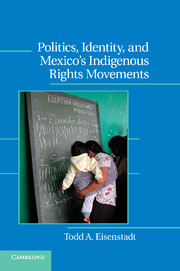Book contents
- Frontmatter
- Contents
- List of Tables and Figures
- Preface and Acknowledgments
- 1 SURVEYING THE SILENCE
- 2 A TALE OF TWO MOVEMENTS
- 3 INDIVIDUAL AND COMMUNITARIAN IDENTITIES IN INDIGENOUS SOUTHERN MEXICO
- 4 AGRARIAN CONFLICT, ARMED REBELLION, AND THE STRUGGLE FOR RIGHTS IN CHIAPAS' LACANDON JUNGLE
- 5 CUSTOMARY PRACTICES, WOMEN'S RIGHTS, AND MULTICULTURAL ELECTIONS IN OAXACA
- 6 FROM BALACLAVAS TO BASEBALL CAPS
- 7 RECONCILING INDIVIDUAL RIGHTS, COMMUNAL RIGHTS, AND AUTONOMY INSTITUTIONS
- Bibliography
- Index
- Titles in the series
4 - AGRARIAN CONFLICT, ARMED REBELLION, AND THE STRUGGLE FOR RIGHTS IN CHIAPAS' LACANDON JUNGLE
Published online by Cambridge University Press: 04 April 2011
- Frontmatter
- Contents
- List of Tables and Figures
- Preface and Acknowledgments
- 1 SURVEYING THE SILENCE
- 2 A TALE OF TWO MOVEMENTS
- 3 INDIVIDUAL AND COMMUNITARIAN IDENTITIES IN INDIGENOUS SOUTHERN MEXICO
- 4 AGRARIAN CONFLICT, ARMED REBELLION, AND THE STRUGGLE FOR RIGHTS IN CHIAPAS' LACANDON JUNGLE
- 5 CUSTOMARY PRACTICES, WOMEN'S RIGHTS, AND MULTICULTURAL ELECTIONS IN OAXACA
- 6 FROM BALACLAVAS TO BASEBALL CAPS
- 7 RECONCILING INDIVIDUAL RIGHTS, COMMUNAL RIGHTS, AND AUTONOMY INSTITUTIONS
- Bibliography
- Index
- Titles in the series
Summary
No one seems to know exactly why, in 1971, sixty-six Lacandons in the Mexican rainforest were granted more than 614,321 hectares (61,400 km2 or nearly 2,400 square miles) of communal land when they had only petitioned for 10,000. Perhaps they should have realized it was too good to be true. After President Echeverría made the grant, his successor, President José López Portillo (1976–1982), regranted a small portion of the Lacandon communal lands to 1,452 petitioners from Chol and Tzeltal indigenous groups who had been encouraged by his government to migrate from the highlands of central Chiapas to the eastern Lacandon lowlands. In 1978, the López Portillo government yet again regranted the Lacandon communal lands, this time declaring that more than half of the land (331,000 hectares) was to become the Montes Azules Biosphere and the Yachilán, Chankin, Bonampak, and Lacantún national parks and protected areas. Tens of thousands of Tzeltales and Choles agreed to concentrate their populations in two urban settlements within the conservation area and Lacandon communal lands. The Lacandon communal assembly members (the original sixty-six grantees), seeing no other means of avoiding being overpowered by the Tzeltal and Chol demographic boom, agreed to allow non-Lacandon members into the communal lands assembly. They insisted, however, that the president always be a Lacandon and that Lacandons always constitute a majority of the assembly to dilute the presence of the Tzeltales and Choles.
- Type
- Chapter
- Information
- Politics, Identity, and Mexico’s Indigenous Rights Movements , pp. 77 - 103Publisher: Cambridge University PressPrint publication year: 2011

